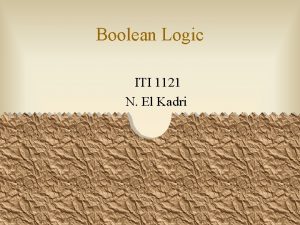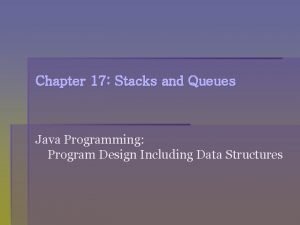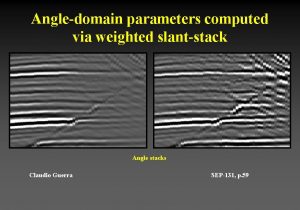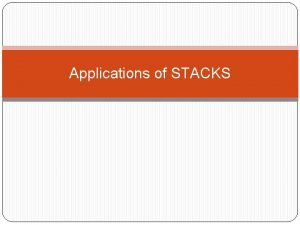Stacks 2 Nour ElKadri ITI 1121 Implementing 2








![Properties of the arrays • Arrays are accessed by index position, e. g. a[3] Properties of the arrays • Arrays are accessed by index position, e. g. a[3]](https://slidetodoc.com/presentation_image_h2/7338af918f94086e36ebfc0418aadcda/image-9.jpg)









- Slides: 18

Stacks - 2 Nour El-Kadri ITI 1121

Implementing 2 stacks in one array and we don’t mean two stacks growing in the same direction: but two stacks growing in opposite directions: 2

Implementing 2 stacks in one array How? • One array but two distinct instance variables for the two tops: Why? Memory management works like that. Such implementation may reduce the amount of memory that is wasted. 3

Primitive vs. reference 4

Earlier we said that pop consists of: 1. saving the current top value, 2. reset stack[top], 3. decrement top, 4. return the saved value. Is it necessary to set the top value to null? 5

Since a reference from the “stack” to the object exists, this prevents the garbage collector from doing its job. 6

No reference to the object, therefore gc() can do its job. 7

Note: error condition • Pre- and post-conditions should be checked and the appropriate Exceptions should be thrown. if (! s. empty()) v = s. pop(); . . . if (! s. is. Full()) s. push(v); 8
![Properties of the arrays Arrays are accessed by index position e g a3 Properties of the arrays • Arrays are accessed by index position, e. g. a[3]](https://slidetodoc.com/presentation_image_h2/7338af918f94086e36ebfc0418aadcda/image-9.jpg)
Properties of the arrays • Arrays are accessed by index position, e. g. a[3] designates the fourth position of the array. • Access to a position is very fast. We say that indexing is a random access operation in the case of the arrays, which means that the access to any element of an array always takes a constant number of steps, we say the operation necessitates constant time, i. e. the time to access an element is independent of: • The size of the array; • The number of elements that are in the array; • The position of the element that we wish to access (first, last, middle). 9

• Access to any element of an array is fast because the elements of an array are stored contiguously in memory. • The array starts at some address of the memory, let’s call this the base address, then the first element is stored at this address and the location of the next element depends on the size of an element. 10

• All the elements of an array occupy the same amount of space and therefore the address of any element is simply, base address+offset where the offset is index _ size of an element • The first element (index = 0) is found at the base address, the second at the base address plus the size of one element, and so on. No search involved. 11

Fixed size arrays • What if the size of an array is not known? Suppose, you were asked to read positive integers from the input until a special value is read (sentinel), say -9, and the values should be stored in a array. 12

• How large should you declare this array? *? Certain programming languages, such as Fortran and Pascal, require you to specify the size of the array at compile time. 13

Solution 1: make it large enough • A possible solution would be to create an array that would be suitable for even the largest application. What are the consequences of such actions? • If the array is too large this wastes a lot memory. • When the array is full the program may be forced to stop. 14

Solution 2: variable size arrays • • • Create an array of a reasonable default capacity. Increase or decrease its size according to the need. This means that the logical size of the array will not correspond to its physical size. Which means that it’s up to the programmer to maintain information about the logical size (the instance variable length of an array refers to its physical size). • It’s the responsibility of the programmer to access elements that are below the logical size. 15

• Qualify the behavior of the solution as the size of the array increases. • All the elements of the array have to be copied. The more elements there are in the array the more copies are needed. • Initially, there are only few elements to be copied, but the larger the array the more copies are needed. • Insertion and resizing are related to one another. • Once the logical size of the array equals its physical size every subsequent insertion necessitates resizing the array, which has a cost that is proportional to the number of elements in the array. 16

• A more practical solution consists of doubling the size of the array whenever the logical size of the array equals its physical size. What have been achieved? • Not all insertions require resizing the array, hence copying its elements. What has been lost? • Memory efficiency. for some applications, the logical size of the array can also decrease, in which cases, the physical size of the array could also be decreased whenever the number of elements is below a certain threshold. 17

1. is the array big enough? 2. where do we start coping the elements? implement remove(int pos) 18
 Iti 1121
Iti 1121 Red cross
Red cross Spring aop static method
Spring aop static method The calydonian boar
The calydonian boar Centre universitaire nour bachir el-bayadh
Centre universitaire nour bachir el-bayadh Nour el kadri
Nour el kadri Anthrax toxin mechanism of action
Anthrax toxin mechanism of action Nour el kadri
Nour el kadri Centre universitaire nour bachir el bayadh
Centre universitaire nour bachir el bayadh Nour fog
Nour fog Nour kadri
Nour kadri Centre universitaire nour el bachir el bayadh
Centre universitaire nour el bachir el bayadh 6 stacks
6 stacks Coastal landforms pictures
Coastal landforms pictures Java stack exercises
Java stack exercises Speedstacks com go
Speedstacks com go Java stacks and queues
Java stacks and queues Two stack pda examples
Two stack pda examples Angle stacks
Angle stacks


































